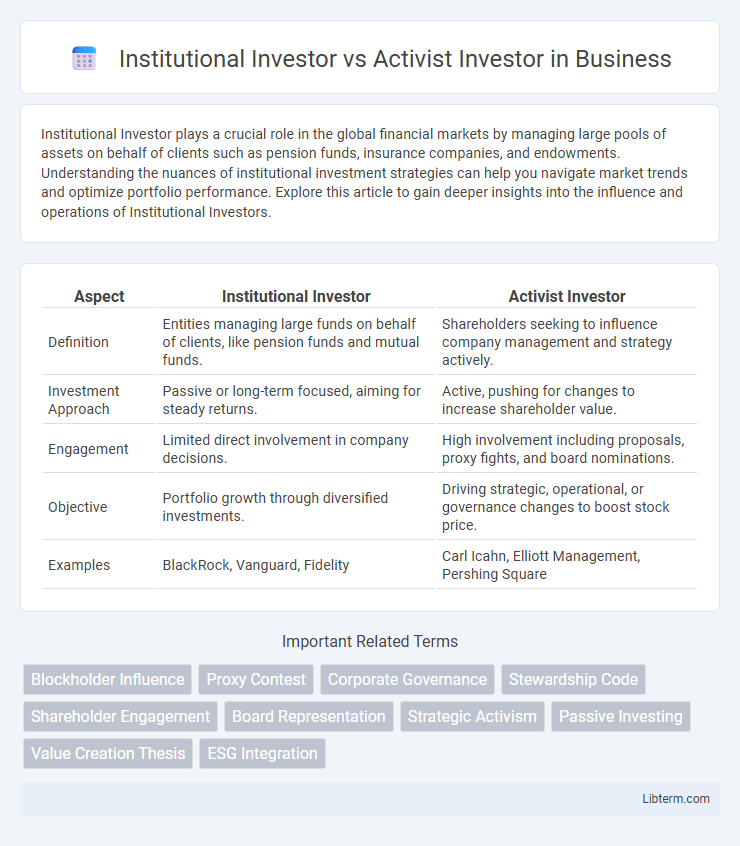Institutional Investor plays a crucial role in the global financial markets by managing large pools of assets on behalf of clients such as pension funds, insurance companies, and endowments. Understanding the nuances of institutional investment strategies can help you navigate market trends and optimize portfolio performance. Explore this article to gain deeper insights into the influence and operations of Institutional Investors.
Table of Comparison
| Aspect | Institutional Investor | Activist Investor |
|---|---|---|
| Definition | Entities managing large funds on behalf of clients, like pension funds and mutual funds. | Shareholders seeking to influence company management and strategy actively. |
| Investment Approach | Passive or long-term focused, aiming for steady returns. | Active, pushing for changes to increase shareholder value. |
| Engagement | Limited direct involvement in company decisions. | High involvement including proposals, proxy fights, and board nominations. |
| Objective | Portfolio growth through diversified investments. | Driving strategic, operational, or governance changes to boost stock price. |
| Examples | BlackRock, Vanguard, Fidelity | Carl Icahn, Elliott Management, Pershing Square |
Overview: Institutional Investors vs Activist Investors
Institutional investors are entities like pension funds, mutual funds, and insurance companies that manage large pools of capital to invest in diversified portfolios for long-term growth and risk management. Activist investors, often hedge funds or private equity firms, acquire significant stakes in target companies to influence management decisions and drive strategic changes aimed at boosting shareholder value. While institutional investors typically adopt a passive or supportive role, activist investors engage more aggressively to reshape corporate policies, governance, and financial strategies.
Defining Institutional Investors
Institutional investors are organizations such as pension funds, mutual funds, insurance companies, and endowments that pool large sums of money to invest in securities, real estate, and other assets. They play a significant role in capital markets due to their substantial assets under management (AUM), often exceeding billions of dollars. Unlike activist investors who seek to influence company management or strategy, institutional investors typically focus on long-term portfolio growth and risk management.
Characteristics of Activist Investors
Activist investors typically acquire significant stakes in companies to influence management decisions and drive strategic changes aimed at increasing shareholder value. They often engage in proxy battles, public campaigns, and negotiations with board members to implement reforms such as cost-cutting, asset sales, or changes in corporate governance. Unlike traditional institutional investors who prioritize passive holdings, activist investors pursue aggressive, hands-on approaches to unlock long-term returns.
Investment Strategies Compared
Institutional investors typically pursue diversified, long-term investment strategies focused on stable returns through asset allocation across equities, bonds, and alternative investments. Activist investors concentrate on acquiring significant stakes in underperforming companies to influence management decisions and drive value through strategic, operational, or financial changes. The key difference lies in institutional investors emphasizing portfolio stability, while activist investors prioritize targeted interventions to unlock shareholder value.
Influence on Corporate Governance
Institutional investors often exert influence on corporate governance through proxy voting and engagement with management to promote long-term value creation. Activist investors typically aim for more immediate changes by pushing for strategic shifts, board restructuring, or operational improvements to unlock shareholder value. Both play critical roles in shaping corporate policies, but activist investors tend to be more aggressive and public in their approach to influencing governance.
Risk Tolerance and Investment Horizon
Institutional investors typically exhibit lower risk tolerance and favor long-term investment horizons, prioritizing steady returns and portfolio diversification. Activist investors demonstrate higher risk tolerance by engaging in aggressive strategies to influence company management, often targeting short- to medium-term gains. The contrasting approaches highlight institutional investors' focus on stability, while activist investors embrace volatility to achieve significant value creation.
Impact on Shareholder Value
Institutional investors typically aim for steady, long-term growth and employ strategies that stabilize shareholder value through diversified portfolios and active engagement in governance. Activist investors often seek immediate or short-term changes by pushing for strategic shifts, cost-cutting, or management restructuring, which can lead to increased volatility but potentially higher returns. The impact on shareholder value depends on the balance between sustainable growth fostered by institutional investors and the aggressive value-enhancement tactics utilized by activist investors.
Notable Examples and Case Studies
Institutional investors such as pension funds and mutual funds typically prioritize long-term portfolio growth, exemplified by Vanguard Group's passive investment approach, while activist investors actively seek to influence corporate strategies, as seen in Carl Icahn's well-documented campaigns at Apple and Occidental Petroleum. Notable case studies include Elliott Management's intervention in AT&T's operational restructuring and Pershing Square Capital's push for change at Herbalife, showcasing the differing tactics and impacts between institutional and activist investors. These examples highlight how activist investors aim for immediate corporate governance changes, contrasting with institutional investors' broader, long-term market influence.
Regulatory Environment and Challenges
Institutional investors operate within a stringent regulatory environment governed by securities laws such as the Investment Company Act of 1940 and the Dodd-Frank Act, which impose compliance requirements on disclosures, fiduciary duties, and trading activities. Activist investors face additional scrutiny from regulatory bodies like the SEC due to their aggressive tactics aimed at influencing corporate governance, often triggering proxy battle rules and tender offer regulations under the Williams Act. Navigating these regulatory frameworks presents challenges including maintaining transparency, avoiding conflicts of interest, and managing the legal risks associated with activist campaigns and shareholder engagements.
Future Trends in Investor Roles
Institutional investors are expected to increasingly incorporate Environmental, Social, and Governance (ESG) criteria into their decision-making, driving sustainable investment trends, while activist investors are likely to adopt more collaborative approaches to influence corporate governance. Technology advancements such as artificial intelligence and big data analytics will enhance both investor types' capabilities in identifying value creation opportunities and risks. The growing emphasis on transparency and stakeholder engagement will redefine the traditional roles, blurring distinctions between passive institutional investing and active shareholder activism.
Institutional Investor Infographic

 libterm.com
libterm.com